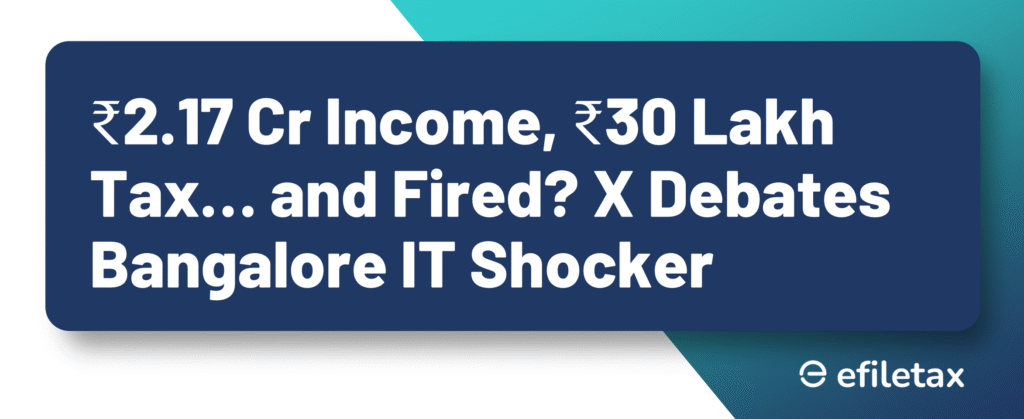
₹2.17 Cr Income, ₹30 Lakh Tax & No Real “Rewards”?
What It Says About the Tax System in India
A recent viral post on X (formerly Twitter) has reignited the debate around the tax system in India. A Bengaluru-based IT professional, reportedly earning ₹2.17 crore annually and paying nearly ₹30 lakh in taxes, was let go by his employer—raising a storm online. The core issue? Despite being a top taxpayer, he felt unrewarded by the system.
Let’s break down what this incident reveals about taxation, social benefits, and what taxpayers actually get in return.
What Was the X Debate About?
- The user claimed he earned ₹2.17 crore, paid around ₹30 lakh in taxes, and still felt “rejected” by the system after being terminated.
- He questioned why there’s no recognition, cushion, or reward from the government despite being in the top 0.01% of taxpayers.
- The post sparked over 2 million views and thousands of replies—some empathizing, others pointing out systemic flaws.
Understanding the Tax System in India
India follows a progressive income tax structure, where higher-income earners pay a higher percentage in taxes.
Income Tax Slabs (FY 2024–25, New Regime):
| Income Range | Tax Rate |
|---|---|
| ₹0 – ₹3,00,000 | Nil |
| ₹3,00,001 – ₹6,00,000 | 5% |
| ₹6,00,001 – ₹9,00,000 | 10% |
| ₹9,00,001 – ₹12,00,000 | 15% |
| ₹12,00,001 – ₹15,00,000 | 20% |
| ₹15,00,001 and above | 30% |
| Surcharge on ₹2 cr+ | 25% |
| Cess | 4% |
👉 A person earning ₹2.17 crore would fall under the highest slab and also pay 25% surcharge, along with 4% health and education cess, making the effective tax liability cross ₹30 lakh.
Do High Taxpayers Get “Nothing” in Return?
India does not have a social rewards model like in Scandinavian countries. Here’s how it compares:
| Aspect | India | Scandinavia (e.g., Sweden) |
|---|---|---|
| Universal Healthcare | Limited (mostly private) | Free for all |
| Unemployment Insurance | Minimal | Strong state support |
| Education Subsidies | Low for higher income | Free or heavily subsidized |
| Taxpayer Recognition | No tangible reward | Public listing of top taxpayers |
Legal & Policy Framework: Why It Is the Way It Is
- Article 265 of the Indian Constitution: “No tax shall be levied or collected except by authority of law.”
- Direct taxes collected go into the Consolidated Fund of India and are used for public welfare.
- No personal benefit model: The law does not allow individual tax rewards or incentives based on how much you pay.
- The Finance Act, 2020 removed certain deductions in the new regime, making taxation flatter and less benefit-driven.
Expert View: Can India Offer Recognition for Honest Taxpayers?
According to tax expert CA Karan Bhatia,
“India doesn’t lack in collecting tax—it lacks in rewarding compliance. A basic social security net for consistent taxpayers could increase trust in the system.”
Practical Suggestions:
- Fast-track services for verified top taxpayers (e.g., passport, visa, loans)
- Taxpayer reward cards with perks like government priority queues or health check-ups
- Public recognition for highest-compliant individuals or firms
What Should High Earners Do?
- Use legitimate exemptions: Even under the old regime, options like HRA, 80C, 80D, and NPS can bring tax liability down.
- Consult tax experts to optimize salary structure (e.g., reduce surcharge via dividend splitting or ESOP deferral).
- Diversify across income heads (capital gains, rental, dividends) for better tax planning.
Explore Efiletax’s ITR Filing Services for personalized tax planning.
FAQs on Tax System in India
Q1: Is ₹30 lakh tax on ₹2.17 crore income accurate?
Yes. Under the new regime, after surcharge and cess, the effective tax crosses 35%.
Q2: Can you get a refund if you lose your job mid-year?
Yes. You can claim refund via ITR if your actual income during the year is lower than projected.
Q3: Are there any government rewards for high taxpayers?
No structured reward scheme exists yet, although proposals have been floated.
Q4: What are the tax-saving options for high earners?
NPS (Section 80CCD), HRA (under old regime), health insurance (Section 80D), and capital gains structuring.
Summary (Google Snippet Version)
A Bengaluru techie earning ₹2.17 crore and paying ₹30 lakh in taxes questioned the fairness of the tax system in India after being fired. The viral post reignited discussions around taxation, lack of social benefits, and what high taxpayers actually get in return.
Final Thoughts
This incident shows growing discontent with the tax system in India, especially among salaried high earners who feel invisible in a system that taxes heavily but offers little in return.